Did you like playing “dress-up” as a kid? I did! And heck, given the opportunity, even as an adult, “playing dress up” for the right occasion is still fun! As the hot Kansas summer wears on, though, the last thing I’d want to do these days is don the clothes that women of the 17th century wore! They were heavy, elaborate, layered, a little constricting – probably not the ideal clothes for 110-degree weather!
Still, they’re fun clothes to look at, and there’s a new book out that gives some detailed insight into women’s clothes of the 17th century. It’s called 17th Century Women’s Dress Patterns, and the book is all that its title promises, and more.
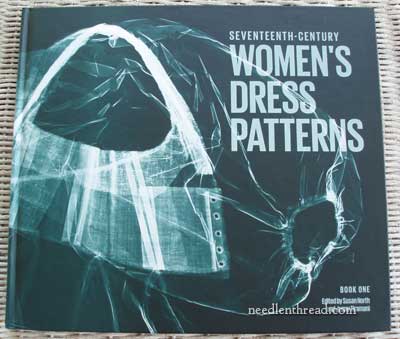
For those of you interested in historical costume, this book is definitely up your alley, I bet! But even if you’re not specifically a costume-maker, you will probably find the book fascinating. After all, everyone has an interest in clothes – we all wear them, to more or less degree – and they’ve been a part of human history for a pretty long time.
Besides the clothes aspect of this book, though, there’s a lot in it for the textile enthusiast in general: historical embroidery, lace-making, glove-making, knitting – they’re all touched on in this book, along with the whole question of how the elaborate women’s garments of the 17th century were constructed.
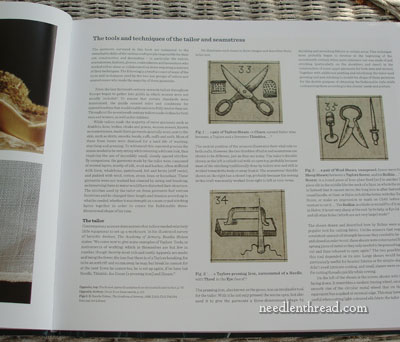
I haven’t read the book cover-to-cover yet, but I have lingered over it, studied the pictures (I always look at pictures first!), read parts of it, and wondered.
The book begins with an introduction to the materials of the age – what did the 17th century tailor and seamstress work with, to achieve their masterpieces of style and fashion? That’s covered in the first few pages of the text. Today, we sit at our computerized sewing machine, surrounded by scissors (usually multiple pairs!), pin cushions, needles, iron and ironing board, special lighting and maybe magnifiers, and all kinds of little accessories that we find necessary to our sewing craft. Not so for the tailors of yore – they were equipped with very little, as far as tools were concerned, but they sure got the most out of what they had.
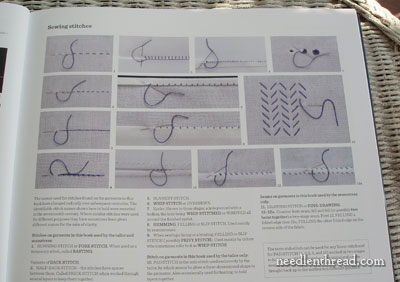
While the book does discuss the historical background of the various subjects addressed, 17th Century Women’s Dress Patterns is mostly an instructional book. And so, you’ll find a section of photos demonstrating the sewing stitches of the day…
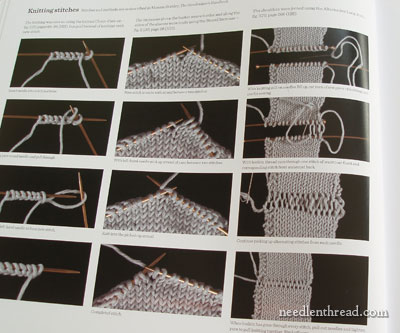
… the knitting method used for creating knit garments…
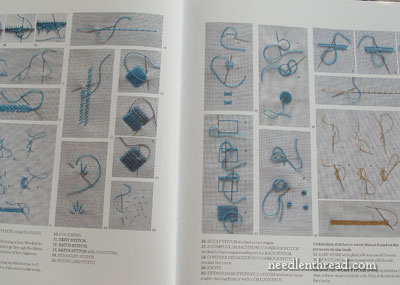
… and don’t forget the decoration! That’s right – there’s a section of demo photos showing the various embroidery stitches used on 17th century garments.
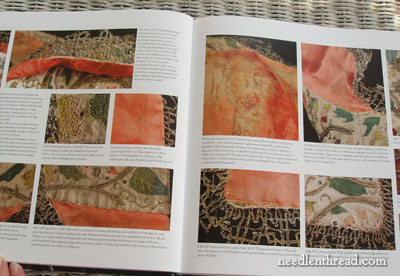
The book looks at various museum items from the era, and it takes them apart for us, explaining what the piece was made of and how it was constructed.
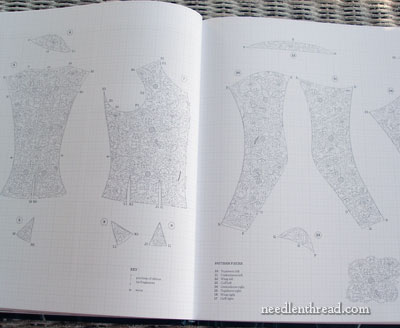
And then, it breaks the piece down into patterns on grids, so that – yes – you can recreate them, if you want to! Even the embroidery designs are laid out on the pattern pieces.
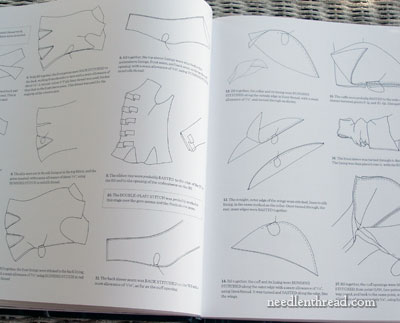
What would pattern pieces be, without detailed instruction on how to put the pieces together? And the instructions – they’re here, too.
The book contains patterns for five waistcoats (several of which are embroidered), bodices, a cape (or mantle), a linen hood and a linen smock, coif, cuffs, sleeves, a kerchief, linen gloves, and kid gloves.
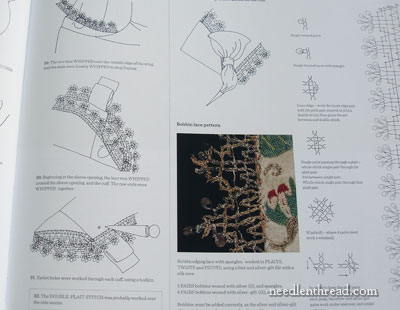
You’ll find information on bobbin lace and even bobbin lace patterns.
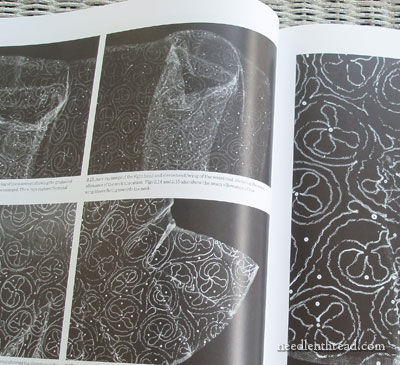
Throughout the book for different pieces, there are photos of x-rays of the museum pieces, that demonstrate how the pieces were constructed.
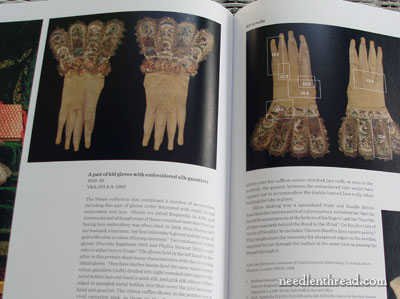
One of my favorite sections in the book is towards the end. It’s the part on gloves. Considering that gloves were an art in themselves and that it takes some skilled hands to create a perfectly fitting pair of gloves, I’ve always found glove construction fascinating. This latter section of the book answers a lot of questions about glove-making, while providing patterns & instructions (and even the embroidery designs for the elaborate cuffs).
I’ve had the book sitting out for a while at home – the perfect test of its attractiveness to “anyone.” Everyone who drops by for a visit, sits for a moment within reach of the book, or just happens to catch a glimpse of it, ends up browsing through it in fascination. And these are people who think my infatuation with needlework is a bit over-the-top. They aren’t into textiles. But…. they like the book! I suppose it’s the universal appeal of clothing (!) and the general fascination that most people have with the past, all woven into one book!
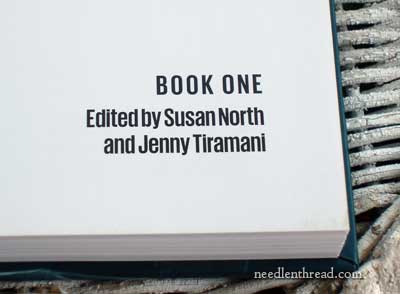
Incidentally, I found this rather enticing. Book One? Does that mean we get a Book Two some day? (Update: Yes, there is a book two!)
I like the book! I think anyone interested in textile history, in costuming, in history, in sewing will like it, too! And chances are, their visitors will, too….
Where to Find
You can find the book through the following book affiliates:
In the US: 17th Century Women’s Dress Patterns, Book 1 through Amazon
You can also find 17th Century Women’s Dress Patterns Book 2 available through Amazon now, if you want to go further with your explorations.
Worldwide: You can find the book here through Book Depository, with free shipping worldwide. They also carry 17th Century Women’s Dress Patterns Book 2 with free world-wide delivery.







Lovely book. My husband and I attend a historical rendezvous every year w/ a time period of pre-1840s. The requirements for dress etc. are very strict so books like these are invaluable.
OOh, this does look fascinating! I’ve also always been intrigued by gloves, and I think this will go on my wishlist, although I know I’ll never actually make anything from it!
Oh, Mary this book is so neat. I’m an absolute textile freak and period clothing, Civil War era is so interesting. I love the make-do ideas. Very cool about all the knitting, too. I really want to learn that someday. Thanks for sharing this with us!
Mary Jo
I love, love, love this book! I, too, got a shot of adrenalin when I noticed it called “Book One”!! Janet Arnold would be proud!
In the product description on Amazon it says “this first book in a new series takes the physical examination and study of historical clothing to a new depth and degree of detail”. It is done by a curator from the V&A and the tailors of the Globe theatre in London. Fascinating! I hope they move forward in time, I would like to see the 18th and 19th centuries done too.
I love “old” clothes, I think I love old anything! I really wish hats and dresses would come back into fashion. Just a side question – how did they keep their gloves clean? Did they have ‘get dirty at home’ pairs and ‘going out’ pairs?
Great! Thank you soooo much!! 🙂
I bought this recently and I love it! Thanks for the review and getting the word out there. The more folks who purchase this book, the better the chance of a volume 2! And you are right about the gloves…I also found that portion fascinating.
Ooooh gloves. I actually have a question about those fabulous gloves – is the embroidered cuff also leather? Or was it simply attached to the leather part and made of something else? I wonder if embroidering leather doesn´t present it´s own challenges.
I´ll put the book on my wish list.
Es sin duda un libro muy ilustrativo de como la moda ha ido evolucionando,un muy buen material de investigacion y apendizaje en lo que a la moda se refiere.
This definitely looks like one I must bug my local library to get. I adore reading about historical costuming and the embroidery stitch guide is icing on the cake.
Ok, I know this is an older entry, but some weeks ago I found a wonderful site where many gloves are on display.
Worked with different materials and from different centuries.
So here is the internetadress if you want to take a look:
http://glovecollectioncatalogue.org/index.html
Greetings